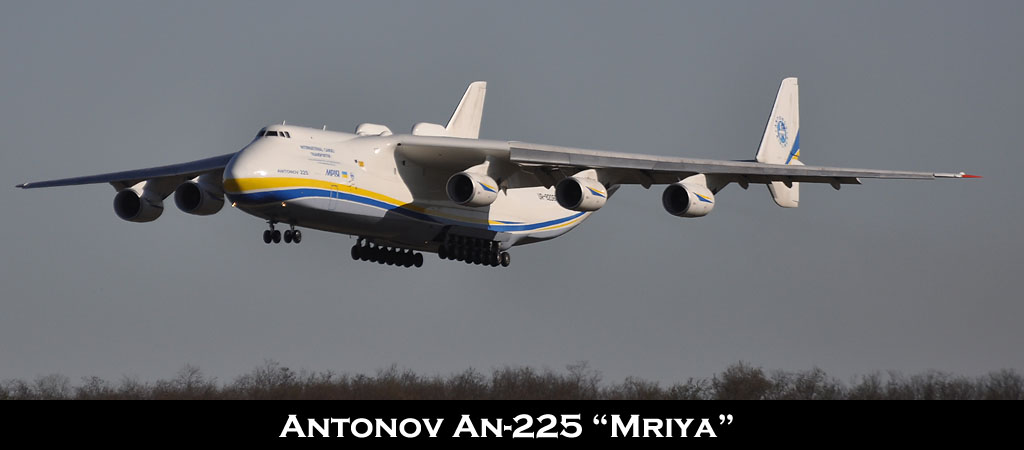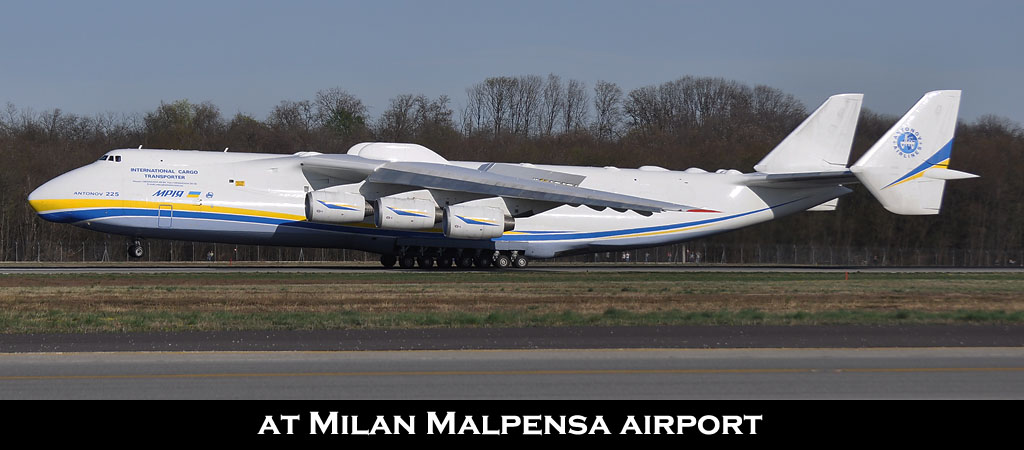 |
 |
 |
 |
 |
 |
 |
 |
| Un carico eccezionale consistente in due grosse componenti industriali della Ettore Zanon di Schio (VI) ha fatto sì che a Malpensa tornasse per la terza volta, dopo qualche anno di assenza, il gigante dei cieli, l’Antonov An-225 Mriya (sogno). Il volo, più volte rimandato a causa della non disponibilità del carico, è stato effettuato tra il 30 ed il 31 marzo. Una perfetta giornata primaverile con aria tersa e cieli azzurri ha accolto l’arrivo del “leviatano” che ha dolcemente posato le sue 32 ruote sull’asfalto della pista 35R alle 17 e 20 locali al termine del volo di posizionamento di 2 ore e 45 minuti dall’aeroporto di Kiev Gostomel dove il costruttore ucraino ha i propri stabilimenti e la principale base di armamento. A bordo solo l’equipaggio ed il tooling necessario per l’assemblaggio della rampa di carico. Il velivolo, accolto da una folla di operatori aeroportuali, giornalisti, spotters e curiosi, che come sempre in questi casi si danno appuntamento nei boschi che circondano l’aeroporto della brughiera, è stato posizionato sul raccordo GW (Golf West) in quanto le normali piazzole di sosta non avrebbero potuto accoglierlo senza penalizzazioni alle vie di rullaggio adiacenti ed ha passato una nottata tranquilla in attesa dell’inizio del carico il mattino successivo. Di buon ora una quindicina di addetti dell’Antonov hanno iniziato a scaricare le centinaia di componenti necessarie per il montaggio della rampa da posizionare davanti al muso aperto del velivolo. Come una sorta di grosso gioco di costruzioni ad incastro (più Meccano che LEGO) la lunga rampa di carico ha iniziato a prendere forma. Solo nel primo pomeriggio il lavoro è stato completato ed è iniziato il carico vero e proprio dei due grossi componenti. Il più grande dei due pesava 113,000 kg. per una lunghezza di 28 metri e 45 centimetri ed un diametro di oltre tre metri, l’altro “solo” 39,900 kg. per 10 metri e 30 centimetri e circa due di diametro. In totale 155 tonnellate di carico pagante. Se si pensa che il peso massimo al decollo di un B737-800 è all’incirca pari a 75 tonnellate significa che la stiva dell’Antonov ha ingurgitato l’equivalente di due di questi jet con relativo equipaggio, passeggeri, bagagli e carburante… Destinatario di questo carico speciale un impianto per la produzione di acido nitrico all’interno di una raffineria nei pressi di Coffeyville, Kansas. A causa della ridotta autonomia del gigante il volo attraverso l’Atlantico è stato pianificato con una serie di tappe per rifornimento: Malpensa - Porto - Lajes (Azzorre) – Gander (Terranova) – Bangor (Maine) – Wichita (Kansas). |
|
|
 |
|
Costruito nel 1988 modificando una cellula del trasporto An-124 Ruslan con lo scopo primario di fungere come vettore di trasporto della navicella spaziale Buran (l’equivalente russo dello Shuttle americano) e dei relativi razzi booster Energia. Le modifiche consistevano nell’allungamento della fusoliera tramite l’inserimento di due sezioni davanti e dietro all’ala, nell’incremento della stessa aggiungendo una sezione alla radice con piloni per due motori supplementari, nell’eliminazione del portellone e della rampa di carico posteriore (al fine di risparmiare peso) e nello sdoppiamento della deriva per consentire il trasporto di carichi esterni sul dorso della fusoliera. La capacità di carico interna raggiunse così i 250.000 Kg., quella esterna i 200.000 Kg. consentendo il trasporto di carichi lunghi sino a 70 m. Purtroppo l’An-225 servì solo per poco tempo nel ruolo per il quale era stato ideato. Il collasso dell’Unione Sovietica nel 1991 ed il conseguente termine del programma Buran fece sì che il velivolo venisse accantonato nel 1994. Per anni rimase inattivo e venne utilizzato come fonte di pezzi di ricambio (in primis i 6 motori) per la flotta di An-124. Verso la fine degli anni ’90 cominciò a manifestarsi l’esigenza di disporre di un trasporto commerciale di maggiori dimensioni rispetto all’An-124 già largamente utilizzato per movimentare carichi “oversize”. Così si procedette al recupero dell’unico An-225 costruito (una seconda cellula giace incompleta a Gostomel) rimontando i motori ed aggiornando l’avionica. Il “nuovo” Mriya ricevette il proprio certificato di navigabilità civile nel maggio 2001 e da allora solca i cieli dei cinque continenti accorrendo ovunque ci sia la necessità di trasportare qualcosa di veramente “eccezionale”. Il Mriya è tuttora considerato l’aereo più grande del mondo sia per dimensioni che per peso. Supera anche il più recente Airbus A380. Solo il gigantesco idrovolante degli anni ’40 voluto dal miliardario americano Howard Hughes, l’H-4 Hercules, poteva vantare un’apertura alare ed un altezza della deriva maggiori, tuttavia praticamente non volò mai e mai entrò in servizio. Inoltre, essendo costruito di legno era sensibilmente più leggero.
Specifiche tecniche/Technical Specifications
Caratteristiche generali/General characteristics
Equipaggio/Crew: 6
Carico pagante/Payload: 250,000 kg (550,000 lb)
Dimensioni portellone/Door dimensions: 440 x 640 cm (14.4 x 21 ft)
Lunghezza/Length: 84 m (275.6 ft)
Apertura alare/Wingspan: 88.4 m (290 ft 2 in)
Altezza/Height: 18.1 m (59.3 ft)
Superficie alare/Wing area: 905 m2 (9,743.7 ft2))
Volume di carico/Cargo Volume: 1,300 m3 (46,000 cu ft)
Peso a vuoto/Empty weight: 285,000 kg (628,315 lb)
Peso massimo al decollo/Max. takeoff weight: 640,000 kg (1,410,000 lb)
Motori/Powerplant: 6 x ZMKB Progress D-18 turbofans, 229.5 kN (51,600 lbf)
Corsa di decollo/Takeoff run: 3,500 m (11,500 ft) with maximum payload
Prestazioni/Performance
Velocità massima/Maximum speed: 850 km/h (460 knots, 530 mph)
Velocità di crociera/Cruise speed: 800 km/h (430 knots, 500 mph)
Autonomia con carburante massimo/Range with maximum fuel: 15,400 km (9,570 mi)
Autonomia con carico massimo/Range with maximum payload: 4,000 km (2,500 mi)
Quota tipica operativa/service ceiling: 11,000 m (36,100 ft)
Carico alare/Wing loading: 662.9 kg/m² (135.5 lb/ft²)
Rapporto peso/potenza/Thrust/weight ratio: 0.234
|
|
|
|
Foto di Giorgio Ciarini e Dario Cocco
Testo di Dario Cocco
Marzo 2012
|
|
English translation
An exceptional load consisting of two major industrial components manufactured by Ettore Zanon of Schio (VI) made possible the return to Malpensa airport for the third time, after some years of absence, of the giant of the skies, the Antonov An-225 Mriya (dream) . The flight, delayed several times due to the unavailability of the load, was performed between March 30th and 31st. A perfect spring day with clear air and blue skies greeted the arrival of the “behemoth” which gently laid its 32 wheels on the asphalt of the 35R at 1720 local at the end of the of 2 hours and 45 minutes positioning flight from Kiev Gostomel where the Ukrainian manufacturer has their own plants and their home base. On board only the crew and the tooling needed for assembly of the loading ramp. The aircraft, greeted by a crowd of airport operators, journalists, spotters and curious, who as always in these cases have been meeting in the woods surrounding the airport, has been parked on the taxiway GW as the normal apron stands could not accommodate it without penalty to the adjacent taxiways and spent a quiet night in waiting of loading scheduled for the next morning. Early in the morning about fifteen Antonov employees started to download the hundreds of components required for assembly of the ramp to be positioned in front of the open nose of the aircraft. As a sort of large interlocking construction toy (more Meccano than LEGO) the long loading ramp began to take shape. Only in the early afternoon the work was completed and the actual loading of the two major components begun. The larger of the two weighing 113.000 kg. for a length of 28 meters and 45 centimeters and a diameter of over three meters, the other "only" 39.900 kg. for 10 meters and 30 centimeters and a diameter of about two. In total 155 tonnes of payload. If you think that the maximum takeoff weight of a B737-800 is approximately equal to 75 tons means that the hold of the Antonov has swallowed the equivalent of two of these jets fully loaded with their crew, passengers, baggages and fuel... Consignee for this special load a plant for the production of nitric acid within a refinery near Coffeyville, Kansas. Because of the limited autonomy of the giant so heavily loaded its flight across the Atlantic was planned with a series of fuel stops: Malpensa - Porto - Lajes (Azores) - Gander (Newfoundland) - Bangor (Maine) - Wichita (Kansas).
It has been built in 1988 by modifying an example of the heavy transport An-124 Ruslan with the primary purpose of acting as a carrier to transport the space shuttle Buran (the Russian equivalent of the US Space Shuttle) and its booster rockets Energia. The changes consisted in lengthening the fuselage by inserting two sections in front of and behind the wing, in the increase of the span by adding a section to the root with pylons for two additional engines, the removal of the rear loading ramp (in order to save weight) and in the splitting of the vertical empennage to allow the transport of external loads on top of the fuselage. The internal load capacity thus reached 250,000 kg, the external one 200,000 kg allowing the transportation of loads up to 70 m. long. Unfortunately, the An-225 was used only briefly in the role for which it was designed. The collapse of the Soviet Union in 1991 and the consequent termination of the Buran program meant that the aircraft was put in storage in 1994. For years it remained inactive and was used as a source of spare parts (especially the 6 engines) for the fleet of An-124. In the late '90s began to manifest the need for a commercial transport larger than the An-124, already widely used to haul "oversized" loads. So the decision was taken to the restore the lone An-225 airframe (a second cell is lying incomplete at Gostomel) into flying condition reassembling engines and updating the avionics. The "new" Mriya received its civil certificate of airworthiness in May 2001 and since then soars through the skies of the five continents rushing wherever there is a need to deliver something truly "unique". The Mriya is still considered the largest aircraft in the world both in size and weight. Exceeds even the newest Airbus A380. Only the giant flying boat of the 40's, wanted by the American billionaire Howard Hughes, the H-4 Hercules, could boast larger wingspan and tail height, however, she hardly ever flew and never entered service. Moreover, being constructed of wood was significantly lighter.
|
|
Images by Giorgio Ciarini and Dario Cocco
Text by Dario Cocco
March 2012
|
|